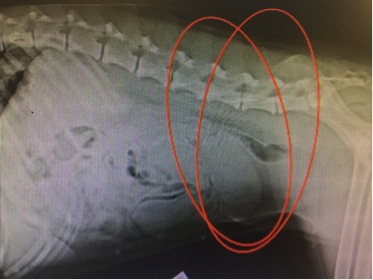Pyometra
Dilated uterine horn
Pyometra occurs when the uterus (female reproductive organ) becomes infected and filled with pus. This generally only occurs in middle-aged to older females that have not been desexed. When females are desexed, generally, both ovaries and the uterus are removed. Rarely, if any of the ovary is left behind in the body, a “stump” pyometra can occur in desexed females.
Risk Factors:
- Progesterone (medications) used to delay or suppress oestrus (heat)
- Oestrogens (medications) used on mismated females
- Post-insemination or post-copulation (post-mating/breeding) infection
- Dioestrus (typically 4-6 weeks after heat)
Symptoms
- Lethargy/quiet demeanour
- Inappetence (not eating)
- Polydipsia and polyuria (drinking and urinating more often)
- Vomiting
- Dehydration
- Fever
Pyometra can be “open” or “closed”. When the cervix is open, purulent and bloody discharge will be seen from the vulva. When closed, no discharge is seen; instead, the abdomen may become swollen or distended from the uterus enlarging with fluid.
Diagnostics
Pyometra can be seen on radiographs (x-rays) and is typically confirmed with an ultrasound. The normal uterus is not seen on x-rays. Both x-rays and ultrasound show evidence of an enlarged, fluid filled uterus. Blood tests may also be performed, which typically shows an increased white cell count and increase in a protein called globulins, produced with inflammation or infection; and anaemia from chronic/long-term disease.
Treatment
While in the emergency hospital, overnight stabilisation will usually be performed. This often involves giving intravenous fluids for rehydration, and starting antibiotic therapy.
The best treatment is to have your patient desexed. This removes the source of infection, and prevents the condition from ever happening again. Antibiotics are also used to treat any remaining infection.
Occasionally, particularly if the patient is to be used for breeding in the future, medical treatment will be used. This typically involves a course of antibiotics, and administration of hormones including prostaglandin, which assists by contributing to expulsion of fluid in the uterus. Medical treatment is avoided, especially with closed pyometra, as it is associated with many side effects and may increase the risk of the uterus rupturing/breaking apart in the body.
Numerous studies report different recurrence rates following pyometra. This has ranged from no additional risk compared with dogs that have never had pyometra, to up to 77% within the first 27 months after treatment.
Prevention
The best prevention for animals not intended to be used for breeding is desexing. Assuming this is performed properly, this will prevent the possibility of pyometra ever occurring, and additionally prevents the possibility of developing uterine or ovarian cancer, and minimises the risk of developing mammary cancers, later in life.


